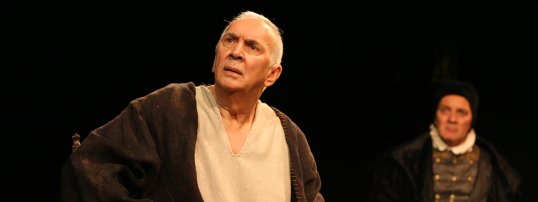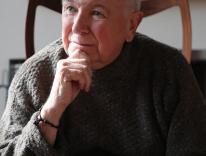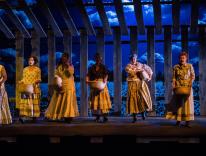
St. Thomas More is claimed as a patron by, among others, lawyers, statesmen, widowers, and step-parents—and by people like me who belong to none of those categories. My own devotion derives from having seen Robert Bolt’s play A Man for All Seasons at an impressionable age, and though my personal St. Thomas has the face of Holbein’s portrait, he thinks and talks like Bolt’s hero, with the thick voice, ready wit, and simmering intensity of Paul Scofield in the 1966 film.
I cherish this version of More even knowing that A Man for All Seasons is an incomplete account of his qualifications for sainthood. Bolt’s play covers only the last six years of More’s life; it hardly mentions the man’s scholarship and conveys little of his spirituality. The stirring eleventh-hour courtroom address omits what may be the real-life statement’s most remarkable feature—More’s prayer that he might meet his judges “merrily” in heaven. But Robert Bolt did not set out to write a devotional text; his subject was Sir Thomas More, who exemplified a commitment to “self” that Bolt considered rare in the sixteenth century and all but extinct in the twentieth. In a preface to the published play, Bolt offers an “apology” for having embraced a Christian saint as “a hero of selfhood,” despite his own secular outlook. (For himself, he says, he seeks “a sense of selfhood without resort to magic.”) Thomas More plainly and repeatedly defends his commitment to the papacy and the church in the course of A Man for All Seasons. Nevertheless, the play’s focus is not on the doctrinal dispute, nor the historical consequences, but on More’s commitment to his conscience regardless of the cost. “I neither could nor would rule my king,” More tells his wife. “But there’s a little...little, area...where I must rule myself.”
Limitations notwithstanding, Bolt’s elegant portrait and the Oscar-winning film it inspired have become the definitive biography for many of More’s admirers. New York City’s Roundabout Theatre Company’s current production of A Man for All Seasons—the play’s first Broadway revival—is at least partly motivated by the general public’s affection for the work. After all, not-for-profit theaters are obliged to serve comfort food to their subscribers from time to time, and this is a text as respectable as it is loved. But while the Roundabout production is plainly influenced by the film, it is not quite accurate to say that it is inspired. And when the subject at hand is a saint, the absence of inspiration is particularly deadly.
The most drastic difference between Bolt’s stage play and his screenplay is the presence in the former of a character called The Common Man. He is the first actor to enter and the last to leave the stage; he plays a number of small roles throughout the course of the play, and between scenes he shares his pragmatic perspective in brief speeches to the audience. This difference between stage and screen has been done away with in the Roundabout revival. Director Doug Hughes sought permission from the Bolt estate to cut the character of The Common Man entirely, and he defends his decision by citing Bolt’s screenplay. In an interview in Roundabout’s magazine Front & Center, Hughes explains that the device of a character who speaks directly to the audience is outdated, and notes that cutting The Common Man has “streamlined” the story. “With all respect, the play’s politics, bitter ironies, and human truths seemed to me better conveyed without the use of a self-conscious narrator,” Hughes says. “I think the audience can be trusted with the significance of it all.” One might question whether omitting The Common Man—just like in the movie!—actually indicates faith in the audience’s sophistication. But the claim that these revisions have “streamlined” the play is certainly not supported by this production.
The self-conscious narrator is undoubtedly an old-fashioned device—Bolt himself wrote that the character never worked as he intended in performance. He hoped that employing this Brechtian alienation technique would “draw the audience into the play” and give them a character to identify with. But critics heard the term “common” in a pejorative sense, and reacted to the perceived insult with umbrage, or (worse) smug approval. Nonetheless, Bolt himself never cut The Common Man from the fabric of the play, and Hughes’s decision to tear him out has left some ungainly holes. The water imagery that flows through the script, suggesting the chaos that lies outside the protection of the law, is compromised. The unity of the many roles played by The Common Man is fractured, and dialogue that once referred to his speeches now makes no sense. Over the course of the play, these little changes cause significant structural damage, draining the dramatic tension and obscuring the story’s message.
Even without The Common Man, Hughes and his cast find ways to hold the audience at arm’s length. All the actors—some excellent, many miscast—speak in the stagy not-quite-British accents of an amateur Shakespeare repertory company. In the role of Thomas More, Tony Award–winner Frank Langella tiptoes around any imitation of Scofield without ever finding his own way into the character. He declaims More’s speeches in his sonorous voice, sliding from a low growl to a noisy shout with studied precision, but the result is cold and artificial. Langella’s calculated posturing and posing is more distracting than any narrator figure could have been.
So what is the “significance of it all,” and what makes Bolt’s story worth reviving onstage when there’s a perfectly good movie available? Hughes seems to believe the plot is the point: while making his cuts he has also dropped a few broad clues into the text, apparently to prevent the trustworthy audience from getting lost in the thicket of history. For Bolt, however, the particulars of history are only the background. His true subject is human integrity—undervalued then and now, despite the lip service we pay to heroes and saints like More. The Common Man does more than comment on the ironies and truths of the play’s events; he calls out our comfortable self-deception, the reason these truths are being presented to us to begin with. In Bolt’s text, The Common Man begins the play as More’s household servant. Events press him into ever more reluctant service as informer, jailer, juror, and executioner. “I’m a plain, simple man and just want to keep out of trouble,” he reminds More as he locks him into a prison cell. “Oh, Sweet Jesus!” More wails. “These plain, simple men!” That exchange remains in this production, but the jailer who imprisons More is just another character—another blind opponent of truth; nothing to do with us. Nothing now stands between us and the temptation to identify with More, or, at least, to congratulate ourselves for recognizing his virtue. Without The Common Man, the play asks no questions and offers no challenges. It merely tells a story whose ending we already know.
This revival closes with Thomas More mounting the stairs to meet the headsman’s ax. In front of him we can see an expanse of white clouds in a blue sky, and the lights fade on the corny image of the saint climbing to his reward. Comfort food, to be sure, but without the lingering flavor Bolt had in mind. The last word in the uncut script belongs to The Common Man. His is the voice that calls out from behind the executioner’s hood, “Behold—the head—of a traitor!” And when the lights come up again, he gratefully removes his mask and bids us farewell. “If we should bump into one another,” he implores, “recognize me.”
From our safe distance, the virtue of Thomas More—canonized saint, Holbein subject, beloved costume-drama hero—is easy to recognize. But up close, from the perspective of The Common Man, it looks very much like folly. The Roundabout’s revival of A Man for All Seasons ignores the irony in Bolt’s title: Robert Whittinton, writing in a Latin textbook some fifteen years before More’s death, praised the great man’s singular wit and remarkable adaptability. More is “a man for all seasons,” Whittinton claims, because he succeeds at whatever the times require. However, what Bolt admires about More, and what he wants us to recognize, is that this knack for survival did not, in the end, prevail. The one who adapts and survives is The Common Man—he is the truly universal figure, the play’s real “man for all seasons.” And that isn’t meant to be comforting.
Pictured: Frank Langella and Zach Grenier in A Man for All Seasons. Photo by Joan Marcus.
Please email comments to [email protected] and join the conversation on our Facebook page.
Previous Story
Light as a Feather
Next Story
Full Stop

